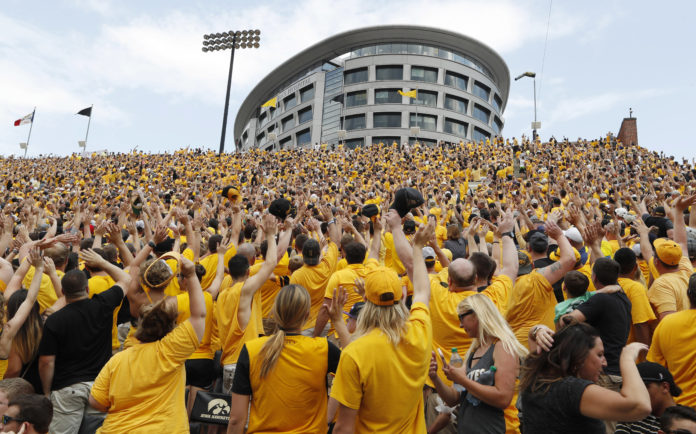
By Adam Gibson | Copy Editor
In Iowa City, Iowa, college football has become so much more than just a game. This is because of one of the newest and most heartwarming traditions in all of sports. With just a simple wave, University of Iowa football fans show their support for young patients in a nearby hospital.
Kinnick Stadium, home of the Iowa Hawkeyes, is located right next to the University of Iowa Stead Family Children’s Hospital, which opened in February. 70,585 fans are able to turn and wave to the top floors of the hospital at the end of the first quarter during every home game.
The idea first came from a Facebook page called Hawkeye Heaven, which is run by Iowa fans. Krista Young, a follower of the page, suggested the idea on June 5.
“So I was thinking… Wouldn’t it be cool if we made it a tradition after the first quarter of every home game to have everyone in Kinnick wave to the kids and their families watching from The University of Iowa Stead Children’s Hospital,” Young said in the post. “Pass this on and let’s make it happen!”
Just a few months later, the wave made its debut. On Sept. 2, when the Hawkeyes played Wyoming in the season-opener, a crowd of over 68,000 turned to wave to the children’s hospital.
The hospital’s communications director, Cheryl Hodgson, said “The Wave” is a special way for the community to show they are there for the kids and that they are rooting for them to get better.
“It’s really the unique thing about Iowa,” Hodgson told the Associated Press. “People care about kids and families everywhere, but we have noticed — first through the ‘Kid Captain’ program [where kids from the hospital are chosen to be the honorary captain for a football game] and now ‘The Wave’ — how much it means to people even if they don’t have a family member directly affected. They really kind of adopt those kids, and it feels like they’re their own and they want to go out of their way to support them.”
At the University of Iowa Family Children’s Hospital, the staff deals with anything from caring for general childhood illnesses, surgery, traumatic injuries, life-threatening and chronic illnesses, and developmental disabilities.
Dr. Paul M. Gordon, Baylor professor and chair of the department of health, human performance and recreation, has worked with children that have various disabilities at the Physical Medicine and Rehabilitation at the University of Michigan. Gordon said through his work, children feel more welcome with such gestures since they tend to be left out.
“These kids, as you might guess, are often overlooked or even stigmatized by society. Their impairments often create challenges to engage in everyday activities and social acceptance is difficult,” Gordon said. “Certainly in my limited experience the children felt a sense of acceptance and support that often helped their mental and emotional states. There is scientific data supporting the benefits of good social support and healing. Even a simple act of kindness can be the difference, providing hope to those in the midst of a crisis. As Christians, we are the hands and feet of Jesus and I would guess that a simple act like ‘The Wave’ can only help remind these children and their families that they aren’t forgotten or ignored.”
Last year, UI Stead Family Children’s Hospital cared for 71,754 patients from every county in Iowa, nearly every state in the United States, and several other countries. The children that are in the hospital have many other problems to worry about, but “The Wave” has become a good distraction from what they are dealing with, even if it is just a temporary distraction.
For the parents of patients in the hospital, “The Wave” has brought life into a dark place.
Amy Clark, a mother whose child is being treated in the hospital, said it creates a feeling of normalcy for the patients in the hospital.
“I guess for me, it brings a sense of excitement to the kids that are here getting treatments or here for long term. And it makes them feel excited and normal for a minute to get out of their rooms and come up here and enjoy themselves,” Clark told the Associated Press. “And I also think it brings a sense of community to everybody that’s out there watching the football game just thinking of us. It’s a neat thing.”
Not only have the fans and Iowa players taken part in waving to the hospital, but opposing teams’ players have also joined in on the trend.
On Nov. 4, Iowa played then ranked No. 6 Ohio State, eventually upsetting it 55-24. At the end of the first quarter, with the score tied at 10, even though the Buckeyes were not happy with how the game had gone so far, the team still turned to wave to the children’s hospital. Ohio State head coach Urban Meyer also took part in the wave and told USAToday that his team was honored to take part in waving for the week.
The Ohio State Athletics Twitter account also tweeted a gif of Ohio State fans waving to represent the fans that did not travel to the game. The tweet was tweeted at the official account of the children’s hospital and said, “UIchildrens from all of us Buckeyes who couldn’t be in Iowa City.”
For the citizens of Iowa, a wave has become more than just a simple gesture. College football now gives to those in the hospital not only entertainment from the game, but loving recognition from 70,000 people in Kinnick Stadium, as well as support from people across the country who have witnessed this selfless tradition.





